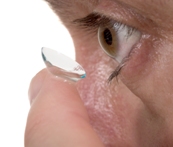Consumer Information
 If your eyesight needs correction to give you best possible vision, contact lenses can be a great solution.
If your eyesight needs correction to give you best possible vision, contact lenses can be a great solution.
Although not everyone can wear them, contact lenses have some definite advantages over spectacles:
- Vision is often better with contact lenses than with spectacles. Your vision isn’t limited by the edge of your spectacle frame and, more importantly, because there is no gap between the lens and your eye, many patients will see more clearly and with less distortion than with spectacles. You see the image as actual size, rather than reduced or magnified
- They are often more convenient as they cannot fall off, break easily or get in the way
- They are invisible nobody need know that you are wearing them
- What correction do you need to see clearly? That is, how short-sighted (which is when you need a ‘negative’ lens, e.g. ‘-2.25’), or long-sighted (needing a ‘positive’ lens, e.g. ‘+2.25’) are you?
- Do you need additional power when looking at close objects, for instance when reading a book?
- Do you have an additional distortion in one or both of your eyes that requires correction? (This is called ‘astigmatism’);
- What is the shape and size of the cornea (the clear front surface) of your eye?
- What are the physiological characteristics of your eye, such as the composition of your tears, the sensitivity of your eye’s surface to foreign bodies, and your blink rate? All these (and more) will help determine the most suitable material for your needs;
- What are your ‘lifestyle’ needs, e.g. Do you want to wear contacts just for special occasions when participating in sports, for example, or on a night out - or would you prefer to wear them all the time?
- Are you good at looking after things, in which case reusable lenses might be a good, cost-effective option - or would you prefer the convenience of daily disposable lenses, which you throw away after each use? (This can also be a particularly good option for those who only want to wear lenses occasionally.)
Your Prescription
When you have your eyes examined by a suitably qualified optician, you are legally entitled to receive a copy of your prescription - the set of numbers that determine what power and shape of spectacle lenses will give you best possible vision.However, this is your spectacle prescription, - this is NOT your contact lens prescription. If you bought contact lenses with the same powers as your spectacle prescription, then they might well be uncomfortable, and they could be dangerous; very rarely would they give you good vision.
A contact lens prescription has to take into account additional factors like the shape of your cornea, sensitivity and so on, as described previously. Once the type (the brand name, e.g. ‘1-Day Acuvue Moist’) of contact lens has been determined, then a calculation can be made, based on your spectacle prescription, that will convert it to a prescription that is specific to that brand.
Typically, the optician will then give you some contact lenses to try (‘trials’), and if you get on with those - you enjoy good vision with no discomfort, and no adverse effects to the eye then that combination of numbers and the specific brand is your CL prescription. If you don’t, your optician may well fit you with another brand name, perform the calculation again, and give you a new set of trials, until you get a contact lens that you and your optician are happy with.

A Typical Contact Lens Prescription
Contact lens prescriptions don’t last forever, though. Not only does your vision change over time, but your cornea does too, so a prescription that is perfect one year may not be perfect the next. And, although modern lenses are extremely safe to wear, it is only common sense to make sure that something that is in direct contact with such a sensitive and important part of your body is not causing any adverse effects.
For these reasons a contact lens prescription is usually valid for just a year, and you should visit your optician at least annually to make sure that your prescription is up-to-date and that your eyes are remaining healthy. Of course, if you feel any discomfort, or feel that your vision has deteriorated in between your regular visits, you should make an aftercare appointment as soon as possible. Many opticians offer schemes where the cost of these visits is covered by a modest regular monthly payment.
Contact Lens Types
Here are a few notes to enable you to look at the specification of a contact lens, and make sense of some the information that you will find on this site. But to repeat once more - they are no substitute for a professional examination and professional advice. If you think that contact lenses might be suitable for you then book an appointment with your optician today!Spherical. These are lenses with a single power (plus or minus), that correct ‘simple’ long sight or short sight.
Toric. These are lenses that have two different powers across their surface at 90° to each other, and are used to correct astigmatism. They are invariably more complex than spherical lenses, and typically more difficult to fit and more expensive to purchase. However in recent years these ‘torics’ have bought the convenience of contact lenses to many millions of astigmatic patients, who would otherwise have had no alternative to wearing spectacles.
MultiFocal: Some people need more powerful lenses for reading and close work than they do for looking at distant objects. This applies to most of us over the age of 45, as our eyes can no longer focus unaided on close objects a condition known as ‘presbyopia’. A major development over the last few years has been the development of ‘multifocal’ contact lenses lenses that can be used to see both in the distance, e.g. when driving, and near, e.g. when using a computer or reading.
Water Content/Material: These are factors that your optician will take into account when recommending lenses for you to try. Amongst other things they determine how long you can wear lenses without removing them, and how comfortable they are.
Replacement Schedule: Lenses are supplied in different ways. Some are supplied ‘in bulk’, in quantities of 30,60 or 90 - each lens is relatively inexpensive and is intended to be thrown away after a single day’s wear.

Many outdoor people wear contact
lenses when participating in their
chosen activity
Other lenses are designed to last much longer anything from a week to a year, and all intervals in between. This can work out to be cheaper than buying the disposable kind. Also, some more complex, ‘custom’ lenses are manufactured to a patient’s individual specification, and are only supplied in this way.
The downside is that lenses that are constantly being removed and inserted need to be looked after, and you need to use appropriate solutions to minimise the risk of infection and remove protein deposits.
Daily Wear/Extended Wear: Lenses are usually designed to be removed at night, and, in the case of daily disposable lenses, thrown away. However, some lenses can be worn 24/7 - so called ‘extended wear’ - both for practical reasons and therapeutic ones. In these cases the lenses will often need replacing more frequently than the same lens only worn on a ‘daily’ basis.